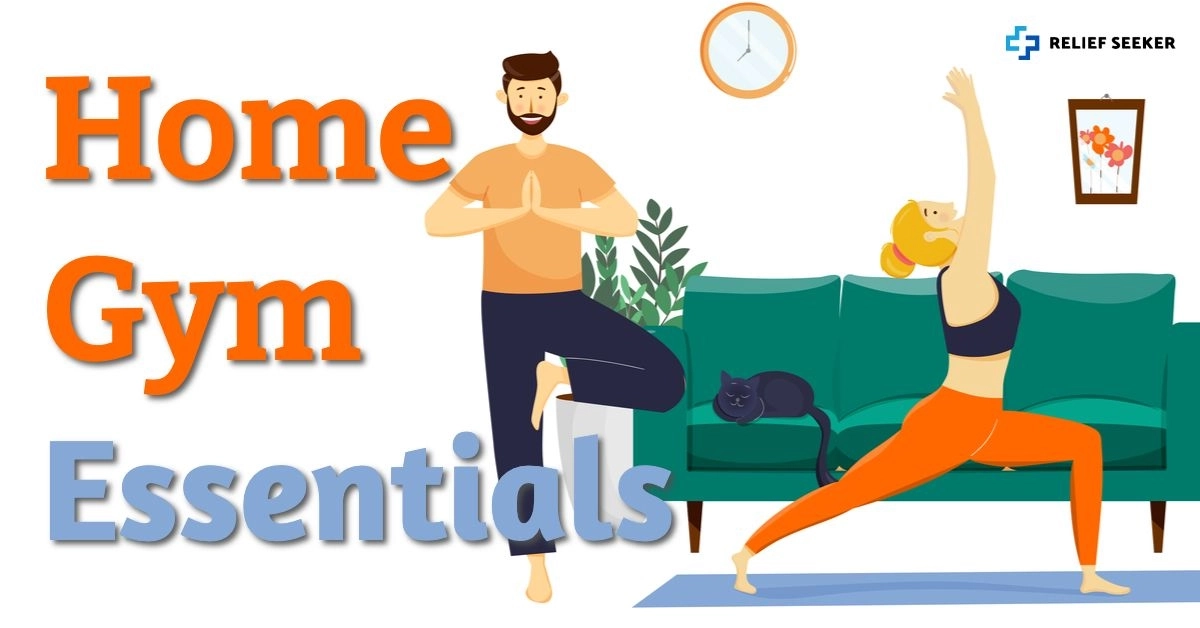Working out at home isn’t always as easy as it is at the gym. Your home probably doesn’t have that high-tech weightlifting equipment or fancy rower available at your local fitness center. Luckily, the best home gyms don’t need fancy equipment to provide a full-body workout. You simply need some home gym equipment essentials to get started.
Discover all the must-have home gym essentials, fitness apps, and trackers you need for the best home workout experience.
Types of Home Gym Equipment
While everyone’s home gym looks a little different, the most common equipment in most home gyms across the U.S.
Cardio
Strength-training
Stretching
Variation
Tracking devices
The most common types of fitness equipment include:
Barbells
Dumbbells
Foam rollers
Free weights
Kettlebells
Pull-up bars
Resistance bands
Rowing machines
Yoga mats
Cardio
Cardio is possibly one of the most important aspects of fitness training and working out. We all need a good combination of cardio, strength training, and stretching exercises in our daily lives.
Cardio is also possibly one of the most difficult exercises to perform at home or indoors — especially without special equipment. While going for a run is often totally feasible (depending on where you live), factors like weather can easily derail your fitness goals.
If you have enough space, you may want to invest in fitness apps and online classes (and possibly some equipment, too). You can easily take online Zumba, dance classes, and even high-intensity interval training (HIIT) classes online.
At-home cardio equipment like treadmills, exercise bikes, and elliptical machines are more expensive but may add value to your workout (especially when used in conjunction with fitness apps and online classes).
Strength-Training
Strength training is a little easier to do at home than cardio. All you need is yourself and your own body weight (though, you may want to invest in a few accessories to help you meet your goals and stave off boredom).
This is another area where fitness apps and online classes are very helpful. Most online trainers show you how to use your body’s weight as resistance (instead of using weights). Some even show you how to use simple household items as strength-training accessories.
Strength-training is just as important as cardio, as it helps build lean muscle, helping our bodies burn even more fat.
If you’re tired of resistance training like pushups and want to add a few pieces of high-end home workout exercise equipment to your own home, there are plenty of systems for that, too.
Stretching
Even if you don’t participate in a long-form stretching program like yoga, you’ll want to stretch before and after your workout (and have a space set up for this activity!).
You can either download some simple stretches from the internet, use stretch suggestions on an exercise app, or use moves recommended by an online doctor or physical therapist.
Online Classes
There are plenty of online exercise classes available in the age of COVID (one of the few lucky aspects of living through a pandemic!).
You can take a spin class with participants from Brazil, a yoga class with Australians, and a dance class with Argentinians.
Many exercises, nutrition, and fitness apps even offer these classes at no extra charge. Simply prop your phone or tablet on a table, and press play. You can also usually sign up for live classes, too.
Variation
Even if you have a sweet home gym equipment setup, you’ll want to prevent boredom and activity fatigue by planning for some variation in your workout routine. Download a fitness app like ClassPass to try new online classes, or sign up for an online dance class or an online shadow boxing class.
Apps like Peloton have a huge schedule of classes, ranging from biking to running, walking, and meditation.
If you work out six days a week, schedule your favorite workouts up to five days a week, and save one day for wildcard exercises.
Fitness Apps
Your home gym doesn’t need to feel like the same-old lame home gym anymore. There are plenty of fitness apps that keep you plugged into your trainers, classes, and workout buddies. The best part is that these apps usually provide fitness data to help you stick to your goals, too.
The two types of fitness apps are fitness tracking and fitness instruction apps. There are a few apps that combine the benefits of these two, though most simply do one or the other (and do it well).
Fitness Tracking Apps
Fitness tracking apps simply track your fitness goals and achievements. Some of these apps even help you create goals if you’re new to working out without a trainer or a health coach.
These apps can track your steps, workouts, heart rate, resting metabolic rate, and other data. Depending on how in-depth your fitness tracking app, you may even be able to detect recovery and active workout quality.
These apps can often be used on their own (without other devices or accessories) but often work best when paired with a smartphone, fitness band, or endurance band.
Fitness Instruction Apps
Some apps also offer fitness instruction. Apps like MyFitnessPal offer instruction videos, nutritional advice, and fitness tracking — though these apps are somewhat rarer (and often don’t offer the highest-quality instructional videos).
Depending on whether or not your app was designed to be paired with a fitness device or band, you may get a better experience if you purchase the correct accessories.
Most fitness instruction apps offer some sort of video or text/infographic instruction. Apps like Weight Loss: Workout at Home even offer personalized workout videos that can be followed both at home or out in nature.
Tracking Devices
Most tracking devices are made to work with corresponding apps (available in the Apple or Google Play stores) and can be connected via Bluetooth.
Fitness Bands
Fitness bands have been gaining popularity for the past decade. What started out as a step tracker has now advanced into a smartwatch, biofeedback strap, or endurance monitor.
These bands can tell you how many steps you’ve walked, stairs you’ve climbed, hours you’ve slept, minutes you’ve worked out, and more. They make it easy to track your calories burned, remember when to start your workout and track your resting or active heart rate.
They even come loaded with apps that teach you how to meditate.
Essentially, they’re fitness trainers for your wrist.
Biofeedback Devices
Biofeedback devices are the next generation of fitness bands. While many of these devices will track your steps, workouts, and heart rates, they’re mostly for tracking your heart rate variation — or the variation or seconds (usually milliseconds) between heartbeats.
Most people use biofeedback devices, like WHOOP and Oura to track their performance and endurance levels. Yet, people are also using these devices to monitor their heart rates to determine if they are suffering from COVID-19 (yes, your heart rate can actually detect if you’re sick or not!).
Nutrition Apps
While nutrition apps fall under a slightly different category than gym equipment, these apps can help you organize your exercise goals and keep them synced with your nutritional goals. Many nutrition apps also sync with your fitness band and other fitness devices to help you keep all your information streamlined in one place.
Weight Watchers
The Weight Watchers app uses the classic WW program, yet this app simply keeps all of your tracking and information in one easy-to-use interface. The app can also sync with your fitness band, stored health data, and other accessories, making it even easier to keep your fitness and nutritional information organized.
WW simply applies a points system to foods and exercises, allowing you to balance your diet, eat plenty of veggies, get more for moving your body — all while drinking enough water and getting enough sleep each night.
Lose It!
Lose It! Is another food tracking and weight-loss app, designed to help you keep all your fitness and nutritional goals in one place. It offers both nutritional and workout guides that connect you with friends and family for data sharing, and can even detect patterns in your workouts and eating habits.
Challenge friends and family to stay motivated in your workouts and nutritional goals. Or, connect with others if you’d rather keep your loved ones out of your exercise goals.
Mindfulness Training Apps
One way to ensure you stick to your physical fitness goals is to start a mindfulness practice, like meditation.
Meditating every day can help you stay grounded in the present, increase your memory and focus, and concentration. It can even help you streamline your workouts, reduce your resting heart rate, and increase your HRV.
If you’re new to meditating (or even if you’re an ole’ pro), meditation apps can help you sit still for longer than just a few seconds. Apps like Calm, Headspace, and Breethe provide meditation instruction, guided meditations (focused on a wide variety of different techniques).
Even though it’s more difficult to work out the way you used to before COVID, you can still get a great workout — both at home and outdoors. In fact, (dare we say?) with the wide variety of accessories, fitness bands, fitness trackers, at-home gym equipment, and online classes, a pandemic may just be the best time to work out!


